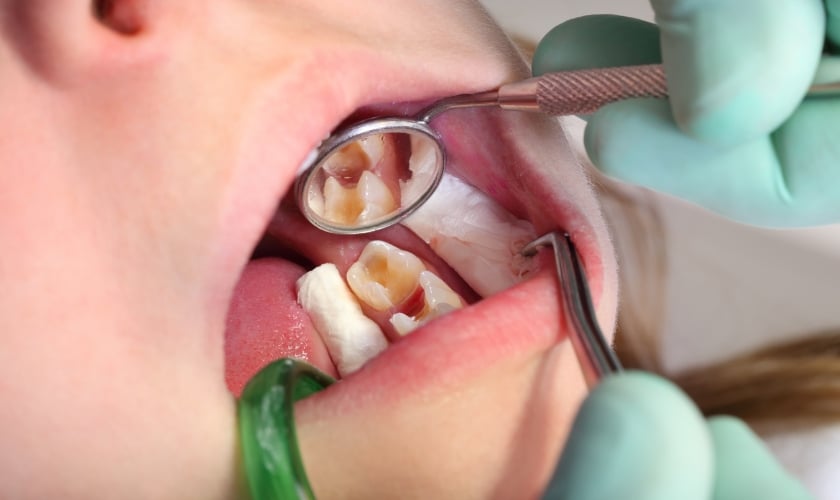Veneers are a common cosmetic dental treatment for improving the appearance of teeth, but what about filled cavities? This article will examine whether veneers may be put over filled cavities. We’ll talk about the feasibility, considerations, and potential problems. In addition, we’ll go over the methods required to prepare cavities for veneers and the many treatment choices available. Always seek the opinion of a skilled dentist for personalized guidance customized to your dental requirements.
What Are Cavities?
Cavities are patches of tooth enamel that acid-producing bacteria have destroyed. They are also known as dental caries or tooth decay. They can cause irritation, sensitivity, and pain. As a result, seeking therapy as soon as feasible is crucial. Filling cavities is a common dental technique used to restore the tooth’s function and prevent future deterioration.
Can Veneers Be Placed Over Filled Cavities?
- Feasibility Assessment: The success of veneer insertion is determined by variables including cavity size, filling stability, and general tooth health.
- Thickness Consideration: Placing a veneer over a filled cavity may need the removal of extra tooth structure, which may jeopardize stability.
- Recurrent Decay Risk: If the infill is weakened during veneer implantation, the danger of microorganisms causing additional degradation increases.
- Dental Evaluation: Dentists examine the tooth and may take X-rays to determine the size of the cavity and any underlying concerns.
- Preparation Process: To make room for the veneer and guarantee perfect fit and alignment, the tooth structure may need to be removed.
- Alternatives: If veneers are impossible, crowns, inlays, onlays, or orthodontic therapy may be explored.
- Consultation with a Dentist: You must visit a knowledgeable dentist who can examine your condition and propose the best treatment strategy.
Preparing Cavities For Veneers:
- Dentist Evaluation: A skilled dentist evaluates the tooth’s condition, confirming the filling is secure enough for veneer insertion.
- X-ray Evaluation: X-rays may determine the extent of the cavities and rule out any underlying problems.
- Tooth Structure Removal: A tiny portion of tooth structure is removed if necessary to make room for the veneer.
- Filling Reinforcement or Replacement: Before proceeding with the veneer application, the dentist may reinforce or replace the filling if necessary.
- Preparation of Veneer to fit: Impressions of the prepped tooth are obtained to manufacture a personalized veneer that fits exactly.
- Temporary Veneer Placement: A temporary veneer may be put on the tooth while the permanent veneer is being created.
- Bonding the Veneer: Once the bespoke veneer is complete, it is attached to the tooth using dental cement to ensure a stable and long-lasting fit.
- Final Modification: The dentist makes Final modifications to guarantee optimal bite alignment and aesthetic attractiveness.
- Follow-up Care: Regular dental check-ups are advised to monitor the veneer’s condition and preserve general oral health.
Alternative Options:
- Dental Crowns: Crowns can be used instead of veneers for teeth with filled cavities. They give whole tooth covering and protection.
- Materials: Inlays and onlays are restorative procedures used to treat moderately damaged teeth. They can be made of various materials, such as porcelain or composite resin.
- Orthodontic therapy: In some circumstances, orthodontic therapy may be a feasible alternative to veneers or expensive dental procedures to correct teeth alignment.
- Consultation with a Dentist: It is essential to get the advice of a skilled dentist who can assess your unique condition and provide the best alternative treatment choices depending on your dental requirements and objectives.
- Pros and Cons Comparison: Discuss the advantages and disadvantages of each alternative option with your dentist to make an informed decision about the most appropriate treatment plan for you.
- Personalized suggestions: Based on aspects such as the state of your teeth, general oral health, and desired outcomes, your dentist will provide personalized suggestions.
- Long-Term Considerations: Before making a final selection, consider the lifespan, durability, and maintenance requirements of each potential option.
While veneers may dramatically improve the look of teeth, installing them over repaired cavities must be done with caution. The state of the cavity, the stability of the filling, and general oral health all play important roles in determining the viability of veneer insertion. It is essential to get the advice of a knowledgeable dentist who can examine your case and propose the best treatment choice for you. Remember that prioritizing your oral health is essential for attaining a stunning smile.
